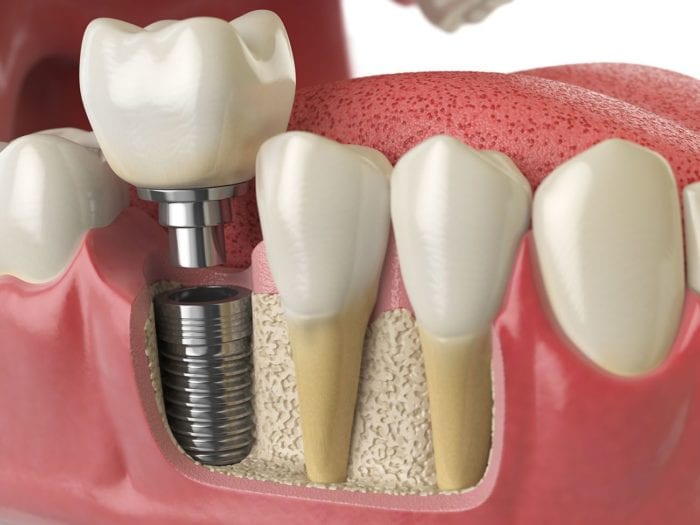The Main Principles Of Dental Implants
Dental Implants for Beginners
Table of ContentsIndicators on Dental Implants You Should KnowMore About Dental ImplantsWhat Does Dental Implants Do?What Does Dental Implants Do?
are clinical tools surgically dental implanted into the jaw to restore a person's capacity to chew or their appearance. They give support for fabricated (fake) teeth, such as crowns, bridges, or dentures. When a tooth is lost because of injury or disease, a person can experience problems such as rapid bone loss, faulty speech, or modifications to eating patterns that cause pain.
Structure of The Dental Implant System choosing dental implants, talk with your oral service provider about the possible advantages and risks, and whether you are a prospect for the treatment. Things to think about: Your overall health is a vital consider determining whether you are an excellent prospect for dental implants, the length of time it will certainly take to recover, and how much time the implant might remain in place.
Smoking cigarettes may impact the healing process and lower the long-lasting success of the implant. The healing process for the implant body might take several months or longer, throughout which time you commonly have a momentary joint instead of the tooth. the dental implant procedure: Thoroughly comply with the dental hygiene instructions offered to you by your dental service provider.
Some Known Details About Dental Implants
Implant failing can lead to the need for another operation to fix or change the dental implant system. Restores the capability to chew Recovers cosmetic look Assists keep the jawbone from reducing due to bone loss Preserves the health of the bordering bone and gum tissues Assists maintain adjacent (nearby) teeth stable Improves high quality of life Damage to surrounding all-natural teeth throughout dental implant placement Injury to the surrounding tissues throughout surgical procedure, such as sinus perforation Injury during surgical treatment (for instance, fracture of bordering jawbone) Insufficient function, such as seeming like the teeth do not bite with each other typically An experience that the tooth is loose or twisting in area arising from a joint screw loosening Implant body failure (looseness of the dental implant body) as a result of systemic infection, which might be more likely in clients with uncontrolled diabetes due to neighborhood infection in bone and gums sustaining the implant body because of delayed healing, which might be most likely in patients who smoke Trouble cleaning up the periodontals around the implant, causing bad oral health Without treatment gum condition Post-surgical numbness because of nerve impingement or damage Always notify wellness care companies and imaging service technicians that you have dental implants prior to any kind of magnetic resonance imaging (MRI) or x-ray treatments.
FDA is not familiar with any type of unfavorable events reported for MRI or x-ray treatments with dental implants. Oral implants systems are typically constructed from materials that follow international consensus criteria of the International Company for Standardization (ISO) or ASTM International. These standards have information of what makes a secure product.
Various other products such as gold alloys, cobalt-based alloys, titanium alloys, or ceramic products are in some cases made use of. The security accounts of these materials are popular. Oral dental implant systems are examined according to worldwide agreement requirements. Biocompatibility testing, to show that physical contact with the tool does not create problems like irritability or allergy, belongs to the assessment that helps ensure the products in the oral implant system are secure and do not trigger negative results when dental implanted in people.

Rumored Buzz on Dental Implants
Some individuals are check it out not eligible for dental implant surgical treatment. It is for oral surgeons to operate individuals with: acute illnessuncontrollable metabolic diseasebone or soft tissue condition or infectionIf these concerns are resolved, an individual can have the surgical procedure. Dental Implants. In, oral specialists avoid running on individuals with: If people with next page any one of the above undergo oral implant surgical procedure, there is a greater risk of the dental implant failing
Some individuals have a jawbone abnormality that prevents adequate bone for a dental implant from creating. In such cases, a specialist may require to perform a ridge adjustment. This entails raising the gum to reveal the location of deformed bone. The cosmetic surgeon will then utilize a bone or bone alternative to fix and accumulate the area.
Dental dental implant surgical procedure is a customized procedure. Give you time to heal. Affix the message and last crown, bridge or denture.
Next, your specialist will meticulously position the oral implant into your jaw. If your dental implant is near the front of your mouth, your dental practitioner will certainly make a momentary tooth for you to use till you heal.
How Dental Implants can Save You Time, Stress, and Money.
Your supplier can inform you what to expect in your circumstance. Throughout the recovery stage, your jawbone should fuse to the dental implant. This procedure, called osseointegration, is vital for security and lasting success. This procedure can take anywhere from three to 9 months. In many cases, it may take longer.
Once your useful link dental implant heals, your dental practitioner can connect the joint (little adapter post) and your last restoration (crown, bridge or denture). This usually takes about one hour to complete and may need a 2nd small surgical procedure. You shouldn't really feel any discomfort during your dental implant procedure because your company will certainly make use of medicine to numb your gum tissues.